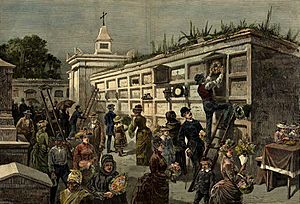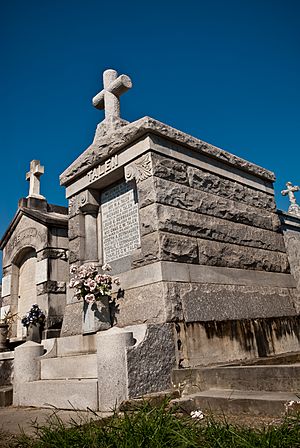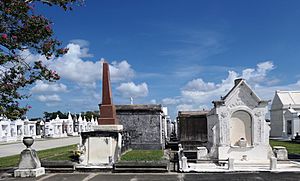Saint Louis Cemetery facts for kids

The Saint Louis Cemetery is the name for three Catholic cemeteries in New Orleans, Louisiana. These cemeteries are famous for their unique above-ground tombs. Most graves are vaults built in the 1700s and 1800s.
Cemeteries No. 1 and No. 2 are important historical sites. They are listed on the National Register of Historic Places and the Louisiana African American Heritage Trail.
Saint Louis Cemetery No. 1
Quick facts for kids |
|
|
St. Louis Cemetery No. 1
|
|
| Location | Bounded by Basin, St. Louis, Conti, and Treme Sts., New Orleans, Louisiana |
|---|---|
| Built | 1789 |
| Architect | Foy, Florville; Monsseaux, P.H. |
| Architectural style | Neo-Classical |
| NRHP reference No. | 75000855 |
| Added to NRHP | July 30, 1975 |
Saint Louis Cemetery No. 1 is the oldest and most well-known. It opened in 1789. It replaced an older cemetery after a big fire in 1788 changed the city's design.
This cemetery is about eight blocks from the Mississippi River. It is just outside the French Quarter. People have been buried here continuously since it opened. You can take tours to learn about its history.
Who is buried in Saint Louis No. 1?
Many famous people from New Orleans are buried here.
- Etienne de Boré was a pioneer in the sugar industry and the first mayor of New Orleans.
- Homer Plessy was involved in a major 1896 Supreme Court case about civil rights.
- Ernest N. "Dutch" Morial was the first African-American mayor of New Orleans. His body was later moved to Cemetery No. 3.
- Alexander Dimitry, a famous writer and teacher, is also buried here with his family.
Famous Figures and Unique Tombs
The famous Voodoo priestess Marie Laveau is believed to be buried in the Glapion family tomb. Other notable people include:
- Bernard de Marigny, a French-Creole leader who founded parts of New Orleans.
- Barthelemy Lafon, an architect who some say was a pirate with Jean Lafitte.
- Paul Morphy, one of the earliest world champions of chess.
- Delphine LaLaurie, a well-known resident.
- Benjamin Henry Latrobe, an architect and engineer, died from yellow fever in 1820 and was buried here.
In 2010, actor Nicolas Cage bought a pyramid-shaped tomb in this cemetery for his future burial.
The cemetery is only one city block in size, but thousands of people are buried there. There is also a section for Protestants, where graves are usually in the ground, not in vaults.
Visiting Saint Louis No. 1
Since March 1, 2015, the Roman Catholic Diocese of New Orleans has restricted public access. This was done to prevent vandalism. Now, only tour companies that pay a fee can bring visitors. Families who own tombs can get a special pass to visit.
Saint Louis Cemetery No. 2
|
St. Louis Cemetery No. 2
|
|
| Location | Bounded by Claiborne, Robertson, St. Louis, and Iberville St., New Orleans, Louisiana |
|---|---|
| Built | 1823 |
| Architect | Multiple |
| Architectural style | Greek Revival, Exotic Revival, Gothic Revival |
| NRHP reference No. | 75000856 |
| Added to NRHP | July 30, 1975 |
Saint Louis No. 2 is about three blocks away from Saint Louis No. 1. It opened in 1823.
Notable Burials in Saint Louis No. 2
Many famous jazz and rhythm & blues musicians are buried here, including Danny Barker and Ernie K. Doe.
- Andre Cailloux (1825-1863), an African-American hero from the American Civil War, is also buried here.
- The Venerable Mother Henriette DeLille, who is being considered for sainthood by the Catholic Church, is also laid to rest here.
Impact of Hurricane Katrina
When Hurricane Katrina hit in 2005, this cemetery had some minor flooding. However, the tombs were mostly unharmed once the water went down. You could only see a brownish waterline on the structures.
Other Important Figures
Many other important people from the 1800s and 1900s are buried here:
- Jacques Villeré (1761-1830), the second Governor of Louisiana.
- Oscar Dunn (1826-1871), who was freed from slavery as a child and became the first elected Black lieutenant governor in a U.S. state.
- Pierre Soulé (1801–1870), a U.S. Senator and U.S. Minister to Spain.
- Paul Capdevielle (1844–1922), a Mayor of New Orleans.
- Ignacy Szymański (1806–1874), a Polish and American soldier who served in the Confederate Army.
- Dominique You (c.1775-1830), a former privateer and hero of the Battle of New Orleans.
- Pierre Nord Alexis (1820–1910), who was the President of Haiti.
Saint Louis Cemetery No. 3
Saint Louis No. 3 is about two miles (3 km) from the French Quarter. It opened in 1854. The tombs here are often more detailed and beautiful than in the other Saint Louis cemeteries. Many have fine marble designs from the 1800s.
Who is buried in Saint Louis No. 3?
People buried here include:
- Paul Sarebresole, a ragtime music composer.
- E. J. Bellocq, a photographer.
- Ralston Crawford, a painter.
- Sweet Emma Barrett (1897-1983), a talented self-taught piano player and singer who helped make New Orleans Jazz famous.
- Former New Orleans mayor Ernest N. "Dutch" Morial was reburied here in a new family tomb.
Saint Louis No. 3 also has a section for the Greek Orthodox community. Like Cemetery No. 2, it was flooded during Hurricane Katrina but the tombs were mostly undamaged, with only some minor plaster damage.
See also
 In Spanish: Cementerio de San Luis para niños
In Spanish: Cementerio de San Luis para niños





